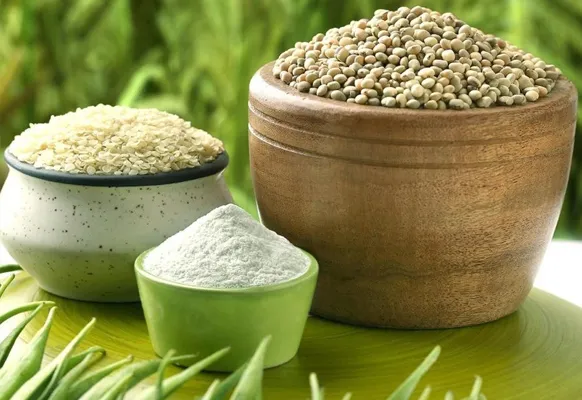“Comparing Guar Gum VS Xanthan Gum: Which One Should You Use?”

When it comes to food thickeners, stabilizers, and emulsifiers, guar gum and xanthan gum are two of the most popular choices in the food industry. Both are widely used in gluten-free baking, dairy products, and sauces, but they have unique properties that make them suitable for different applications.
So, which one should you use? This guide will compare guar gum vs xanthan gum based on origin, properties, usage, benefits, and costs to help you make the right choice.
Side-by-Side Comparison of Guar Gum VS Xanthan Gum
| Feature | Guar Gum | Xanthan Gum |
|---|---|---|
| Source | Guar plant seeds | Fermented sugar (bacteria) |
| Solubility | Best in cold water | Works in hot & cold water |
| Thickening Power | High viscosity | Medium viscosity |
| Acid Stability | Less stable | More stable |
| Best for | Ice creams, soups, gluten-free baking | Dressings, sauces, gluten-free dough |
| Cost | More affordable | More expensive |
| Vegan & Gluten-Free | ✅ Yes | ✅ Yes |
Which One Should You Use?
Use Guar Gum If:
- You need a cost-effective thickener for ice creams, dairy, and gluten-free baking.
- Your product requires moisture retention and texture improvement.
- You want a plant-based, natural stabilizer.
Use Xanthan Gum If:
- You need a stabilizer that works in acidic foods like dressings and sauces.
- You require better dough elasticity for gluten-free baking.
- You are looking for an ingredient that works in both hot and cold applications.

Why Guar Gum is a Must-Have Ingredient in the Food Industry
In the modern food industry, manufacturers rely on natural additives to enhance texture, stability, and shelf life. Guar gum, a plant-based thickener and stabilizer, has emerged as a top choice for food producers worldwide. Whether in baked goods, dairy products, or gluten-free recipes, guar gum plays a crucial role in maintaining product quality.
Key Benefits of Guar Gum in the Food Industry
1. A Powerful Thickening Agent
Guar gum is one of the most effective natural food thickeners, requiring a small amount to achieve significant viscosity. It is commonly used in:
- Sauces and dressings, Soups and gravies, Ice creams and dairy products
2. Natural Stabilizer for Dairy and Beverages
In dairy products, guar gum acts as a stabilizing agent, preventing ingredient separation and improving texture. It is widely used in:
- Ice creams (prevents ice crystal formation), Yogurts and flavored milk, Plant-based milk (almond, soy, and coconut milk)
3. Essential for Gluten-Free Baking
For consumers following a gluten-free diet, guar gum is a perfect substitute for gluten. It improves the elasticity and structure of baked goods, making it a must-have for:
- Gluten-free bread and cakes, Pizza dough and tortillas, Pasta and noodles
4. Extends Shelf Life Naturally
Guar gum helps retain moisture in processed foods, preventing them from drying out. This property is valuable in:
- Packaged and frozen foods, Bakery products, Ready-to-eat meals
Key applications of guar gum in the paper industry
1. Bio-Based Barrier Coatings for Sustainable Packaging
With the growing demand for eco-friendly packaging, guar gum is being explored as a biodegradable barrier coating to replace synthetic chemicals in food packaging papers.
2. Enhanced Paper Strength and Printability
Recent developments suggest that guar gum, when modified with nanocellulose or starch blends, improves tear strength, burst resistance, and printability of paper.
3. Guar Gum as a Microplastic-Free Additive
With increasing bans on microplastics in industrial applications, guar gum is being researched as a natural retention aid and binder in paper coatings, replacing synthetic binders like polyacrylates.
4. Smart Paper and Conductive Inks
Scientists are experimenting with guar gum to develop smart paper that can react to humidity, temperature, or pressure. Additionally, guar gum-based conductive inks are being tested for flexible electronic applications, such as paper-based sensors and RFID tags.
5. Eco-Friendly Paper Adhesives
Guar gum-based adhesives are being developed as a green alternative to synthetic glue used in paper laminations, envelopes, and bookbinding, reducing reliance on petroleum-based adhesives.
Conclusion
Both guar gum and xanthan gum are excellent food additives, but they serve different purposes. If you’re in the dairy, baking, or frozen food industry, guar gum is the best choice due to its affordability and high thickening power. However, if you need a stronger stabilizer for acidic foods or gluten-free dough, xanthan gum is more effective.
Looking for a trusted guar gum supplier? At Redone Impex, we provide high-quality guar gum for food, pharma, and industrial applications.
Contact us today for bulk inquiries!







I like this site very much so much superb information.